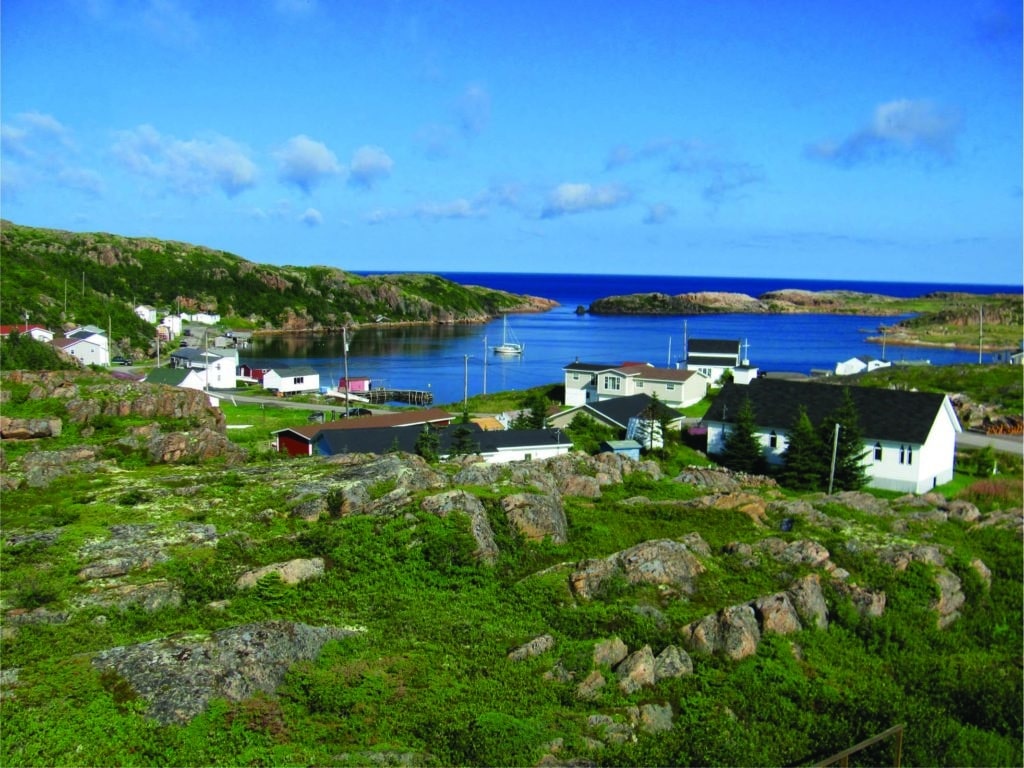
If someone had told me that less than 1,000 miles from the well-traveled waters of New England lay an enchanted island of breathtaking beauty, teeming with wildlife, carpeted in edible berries, inhabited by the most generous people on Earth, and absolutely riddled with harbors, bays, inlets and anchorages, I probably wouldn’t have believed it. If they had added that, in spite of these charms, you could sail there all summer and barely see another cruising boat, I also wouldn’t have believed it. Any of it. I would have chalked it up to the superlatives that sailors commonly use for their own favorite or most frequented cruising grounds — in some cases their only cruising grounds. We’ve sailed to lots of people’s favorite places — and have some of our own — but never found one that was head and shoulders better than all the rest. That is, until we accidentally wound up cruising in the one I’ve just described —which we’d barely even heard of.
We hadn’t actually meant to explore Newfoundland at all. It was only to be a stopover on our bigger plan to cross the Atlantic Ocean to Ireland. But plans, as they often do, fall apart and get changed, and early in 2013 we found ourselves in a deep bay on the southeast corner of Newfoundland with a whole summer before us. We had a choice: go back to St. Pierre and Miquelon, from where we’d sailed several days before, and then back to Cape Breton Island and the Nova Scotia coast; or sail around Newfoundland counterclockwise and see what it had to offer. Since my wife, Danielle, hated turning back, we needed a consolation prize after having to abandon our long-cherished transatlantic ambitions. So we decided to press on northward, and were rewarded by the discovery of an amazing cruising ground that exceeded all superlatives, staggered the imagination and left us breathless at nearly every turn.
Around the corner of the island at Cape Race, the coast is indented by a series of deep fjords whose cliffs are alive with nesting seabirds: puffins, terns and gannets mostly, but it’s not unusual to see a bald eagle or two winging majestically by or sitting stately in a lofty pine. The Avalon Peninsula ports, Fermeuse, Aquaforte and Cape Broyle, provide shelter for boats waiting to round notorious Cape Race, or relief for those who just have. The Labrador Current, traveling south along the Atlantic shore of the island, mixes with the warm, fog-generating waters of the Gulf Stream just there, adding an extra measure of intrigue to an already formidable cape.
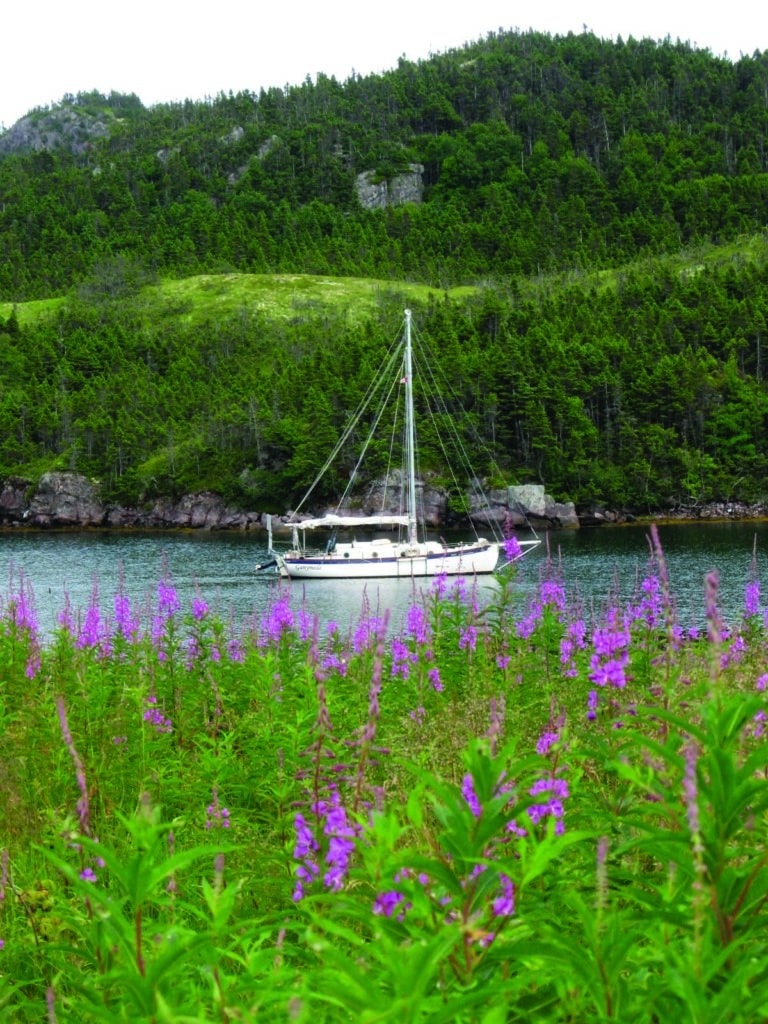
In spite of the offshore breezes that accelerate to astonishing force as they funnel down the narrow fjords, we found these harbors a very pleasant introduction to island life and what we could look forward to ahead. Sitting out some weather in Cape Broyle (we needn’t have bothered — the endless wind was local, and it was not blowing at all out at sea) we discovered one of the many pleasant aspects of Newfoundland cruising. “That’s a bit of a piece to row ashore from your boat,” several locals observed in their charming Irish-like accent. “Why don’t ye tie up to yonder public wharf?” “We don’t want to take anyone’s spot without permission,” we protested.
“Bless you, that’s not no one’s spot. If there’s room, you ties up, and it’s your spot.”
We were still wary. “For how long?”
“As long as you wants!” they laughed. “It’s a public wharf.”
It proved true, and we realized as time went by that you could almost cruise Newfoundland without a dinghy — or “go-ashore boat” as they call it. Nearly every harbor has a public wharf, and the highest we ever paid was $10 per night. Mostly we paid nothing, and in some places it seemed that the harbormaster intentionally avoided us so as not to have to charge a fee at all. It’s just the sort of people they are. By the time we were at Savage Cove, our last port of call on the island, we had tied wharfside in exactly half the harbors we’d visited, and had to pay in less than half of those.
Though we’d been warned of icebergs along this stretch, we saw none as we sailed toward the capital city, St. John’s. What we did see, mostly while crossing the wildlife sanctuary of Witless Bay, were whales, pods and pods of them, as well as birds innumerable. The children sat in the sun on the foredeck and laughed whenever a startled puffin took off at a right angle to the boat, his stubby legs pounding the water comically until his wings caught up.
In contrast to the sleepy fishing towns that we mostly explored on our cruise, St. John’s is a busy, bustling metropolis. It’s a great place to stock up before heading into more remote parts, especially because you can barely go ashore from the wharves reserved for transients without some outgoing local offering you a ride. Costco, Walmart, Best Buy, ship chandleries, gas, propane, laundry — all the benefits of a big city, with a friendly lift to anywhere you need to go. For those who’ve been cooped up aboard too long, there’s a narrow walking trail along the steep cliffs that guard the harbor entrance, past gun placements from 1812 and World War II, up to the historic Cabot Tower, where the first transatlantic wireless message was received in 1901.
We could happily have spent a few weeks exploring the nooks and crannies of that ancient city, and watching the giant oil-rig tenders, container ships, cruise ships and fishing vessels that come and go day and night without stop, but there was a lot of coast yet to cruise, and the short summer was getting along — in fact, the only two truly warm days we had that year happened there. The day after we left under double-reefed main to sail past Cape St. Francis and Bay de Verde to the quaintly named port of Old Perlican, we had to put on wool sweaters, which rarely came off for the rest of the summer.
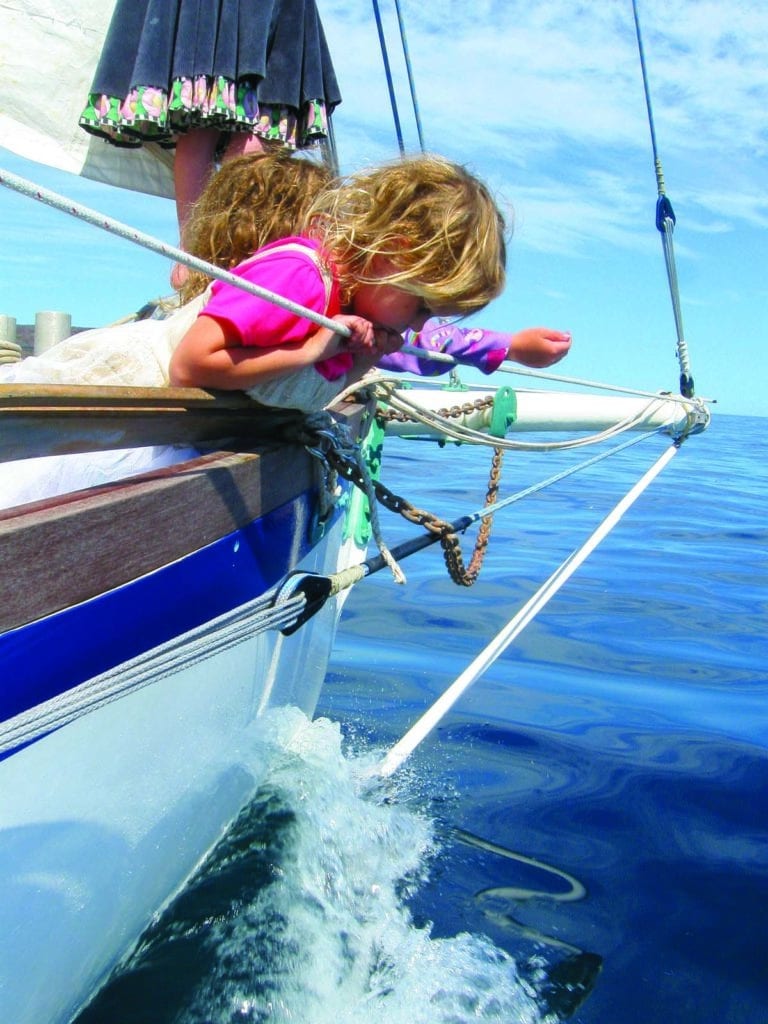
The north coast of Newfoundland is indented by three or four major bays, each supplied generously with harbors and islands. Conception Bay, Trinity Bay, Bonavista Bay and Notre Dame Bay could easily be cruised for a whole season apiece without running out of places to go. Unlike the south coast, it has very little fog, since the prevailing southwest wind dries out while blowing over the land. We had time only to skim the surface, sailing from cape to cape without going deep into each bay. We left each one behind with only regrets that we couldn’t explore it more fully. Who wouldn’t want to go to places with names like Heart’s Content and Heart’s Desire? But we had to be heartlessly selective. As it was, it was on this coast that we discovered what we unanimously agreed to be the most beautiful and serene harbor Ganymede has ever anchored in.
“Welcome to Traytown, Population: Zero,” reads the lonely sign as you enter a narrow gorge on Ireland’s Eye island. Inside the tiny harbor the water was clear as glass, the air was fresh with the scent of pines and a bald eagle stood quietly on a high, mossy rock. Ashore were a few seasonal fishing cabins, and a web of overgrown trails led between patches of wild blueberries, moldering graveyards and the remains of houses long abandoned. It was all so peaceful, so dreamy, it was as though time wasn’t being measured at all.
That’s not to say that other spots were a disappointment — they weren’t — but every place was different from the last, sometimes markedly so. On Fogo Island we encountered pink, rounded rock formations similar to those on the Quebec coast; a day away in Lumsden South there had been a beach to rival many in the Caribbean; just before that at Pork Island it was piney granite cliffs dropping straight into deep green water.
Each change in topography left us wondering how much more variety there could be, and each new place we sailed revealed that Mother Nature still had plenty more up her sleeve. We saw less than 5 percent of what the coastline has to offer, and in that little bit was more of nature’s majestic splendor than we’d seen in the 10,000 miles under the keel since Ganymede first left California in 2009.
What did not change, but that we never tired of, was the goodness of the people of Newfoundland. From our first encounter with a “Newfie” at St. Pierre (who helped our daughter Antigone clean some tiny codfish she caught, and who gave us several jars of home-preserved caribou and clams) to the last one (who gave me a lift to the grocery store in Savage Cove), we found them to be the most universally friendly and giving folk anywhere. In all the other places we’ve sailed there have been people, here and there, who stood out as genuinely, sincerely happy to meet us — to help us if need be, to simply make acquaintance if not, and pass the time of day. But far more often in other places the approach of strangers meant we were going to be begged from, or sold something, or charged some sort of made-up “anchoring fee.” Not in Newfoundland. Here the approach of strangers means only one thing: They want to give you something or see if they can help. One has only to begin walking down the road with fuel jugs in hand, and it would be strange for the first passing car not to pull over and offer a lift.
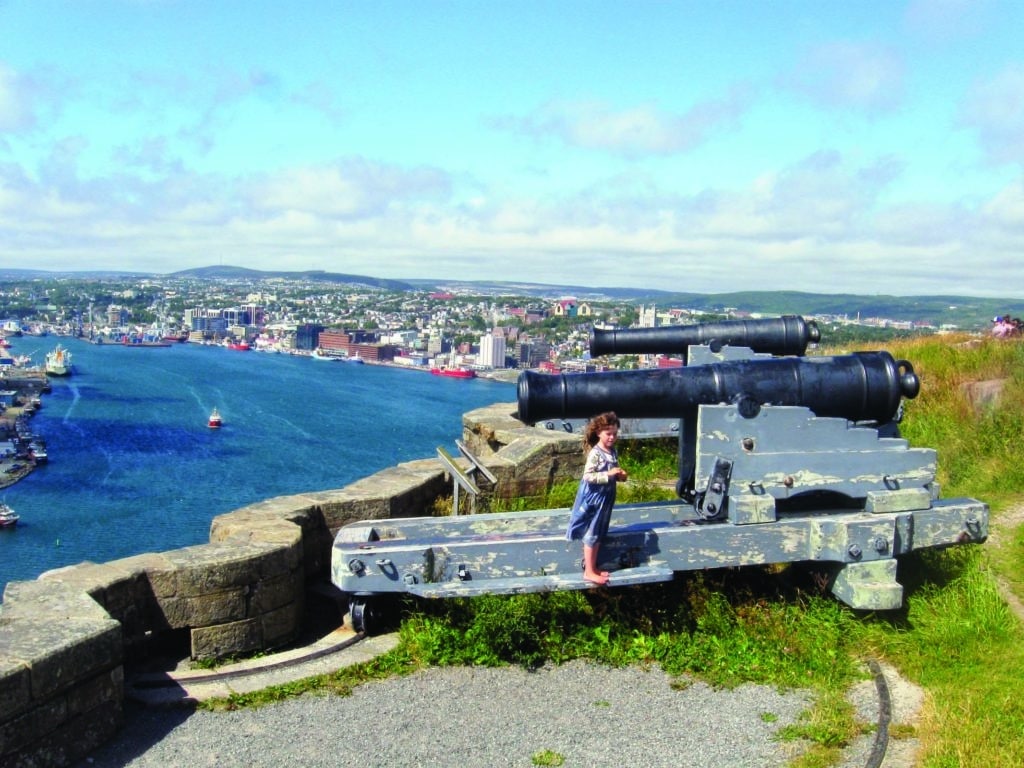
Often, walking along a road, we were waylaid by someone calling out from his or her porch to invite us up for a bowl of soup or a gam, and folk typically came right down to the boat to see what they could bring. Fresh vegetables from their garden? Charts to the Strait of Belle Isle? Seafood? Blueberry muffins? Use of their washer? All these things and more were poured freely forth in abundance by people so generous by nature that they don’t even think they’re doing good — it’s what’s done every day in Newfoundland.
There are downsides, of course, to this cruising ground — even paradise has its price. The biggest one is the shocking lack of groceries. Though there are grocery stores, per se, which even on a casual cruising schedule can be visited every week or so, they’re not always very well stocked, and the vast majority are the convenience-store sort, with anything remotely fresh becoming quickly rubbery in its small glass hutch. Apart from St. John’s, which as a busy international shipping port has absolutely everything, we saw only two cities with a choice of grocery stores. But even when the selection was decent, the prices were not — it felt strange to pay more per pound for vegetables like broccoli than for pork chops, and to pay more for margarine than we normally do in the States for butter. Some prices placed even staples almost out of reach — milk weighed in at an astronomical $10 a gallon, and we gave up entirely on things like chips and salsa. The locals are so used to everything being canned or frozen that some had never thought to try the rubbery veggies behind the glass, and the major part of all their diets is meat. What places don’t have fresh beef and pork have them in every frozen and preserved state imaginable. You can even buy an entire bucket of pickled beef, or simply fish out as much as you need with a hook from the open tub every store seems to have available.
Even their most abundant and delicious food source, seafood, has suffered from their necessarily insular ways. Whenever we were given a few fillets of codfish or some mackerel, they were attended with cooking directions. “What you does, is you takes pork lard — what we calls ‘fatback’ — and melts it in a pan, and then you fries the fish.”
My answer of “Not me. I aim to drizzle it with olive oil, sprinkle on dill and paprika and bake it in the oven,” invariably met with stares of incomprehension.
“Or you boils it with potatoes,” was usually their second try. Actually not a terrible idea. I had never considered myself a tuber connoisseur, but I can say without reservation that the potatoes in Newfoundland were far and away the finest I’ve ever tasted. Maybe it’s the islanders’ Irish roots, maybe it’s the climate, likely a little of both; but not only were the spuds heavenly, they were the cheapest food going. Even better were freshly dug ones from garden plots that dot the landscape, some of them less than a foot from the high-tide mark.
As the coast takes a sharp right turn to form the Great Northern Peninsula, English place names like Round Harbor and Fortune give way to handles like La Scie, Fleur-de-Lys and Grandois. This upper portion of coast was used in time out of mind by French whalers and cod fishermen whose memory lives in the names they left, though little else remains. Here the distance between settlements is farther, the outposts — villages inaccessible by road — are more remote. Many harbors, even very good ones, remain uninhabited, and the katabatic breezes are even wilder than in the southern fjords.
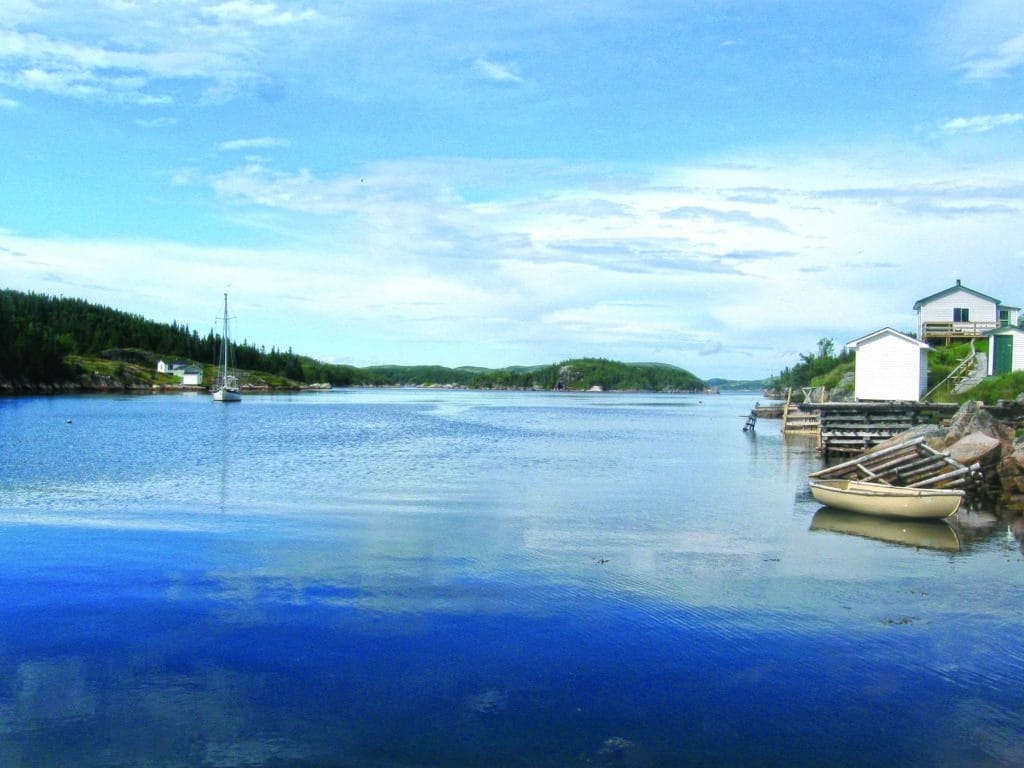
Near the very tip of the peninsula, at the threshold of the Strait of Belle Isle, the major city of St. Anthony (it boasts two grocery stores), is home to an important regional hospital, and was Wilfred Grenfell’s base of operations for his famous medical work in Labrador. As in the rest of Newfoundland, which is careful to preserve its wonderfully rich history, the past seems to be still in progress. Some of the old Grenfell mission buildings still remain, such as the original hospital and historic churches. From the well-sheltered anchorage you can hear on weekdays an authentic steam whistle still calling workers to begin the day and dismissing them at the end.
The scariest, and potentially hardest, part of sailing around Newfoundland is the Strait of Belle Isle. Since the prevailing weather is from the southwest, most people go around the island clockwise, and if they get too much wind in the Strait, at least it’s from astern. Quite often there is rather a lot of it, plus respectable tidal currents, frequent fog and abundant icebergs, mixed in with shipping of all sorts. We had read stories of, and knew personally, folks who had tacked for days back and forth across the Strait between Newfoundland and Labrador, trying to pass through to the Gulf of St. Lawrence as we needed to. It didn’t help that, in September, sailing season was officially over: The fishermen had mostly packed it in for the year, and there was a tropical storm or two spinning away out in the North Atlantic. We had thought then, sitting out our third gale in 10 days in a small bay at the very northern end of Newfoundland — and not knowing whether we’d get through the Strait or not — that we’d be pretty happy to see the last of Newfoundland. We regretted that unkind thought when as a reward for our patience we got a perfectly quiet day to traverse the Strait, with a following wind, no sign of fog and a fair current that got us through to Savage Cove with hours of daylight to spare.
The next morning we sailed out to cross the Strait to the mainland coast of Quebec. We had arrived in Newfoundland, months before, at Trepassey Bay in the fog, and now as we left, a fog rolled in to hide the island from view. The relatively little we’d seen of Newfoundland had left a deep impression. Nowhere else has nature been so varied, so rich, so exuberantly wild; nowhere else have we felt such a warm connection to the people. They had loved us, simply for being us, for being there. It’s a wonderful feeling, and connected to such a wonderful place, it’s no wonder we were sorry to have to leave.
– – –
The Zartmans are currently living in Bristol, Rhode Island, while making improvements to Ganymede and warming their winter with memories of voyages past.








